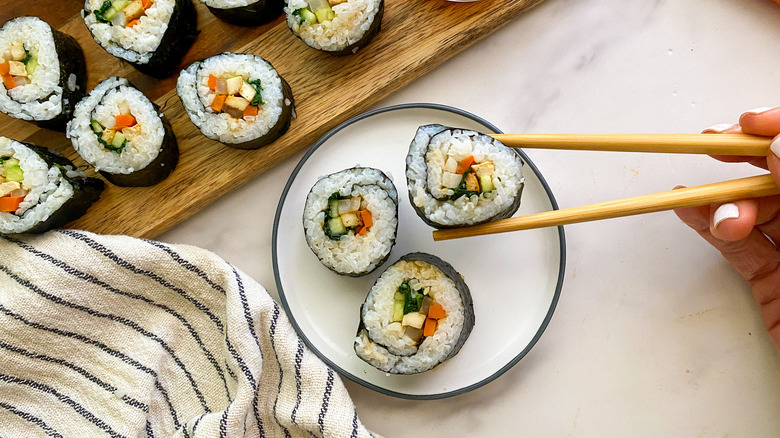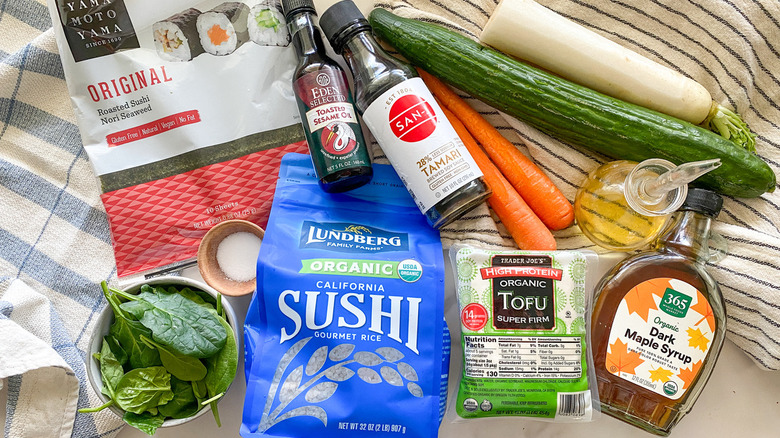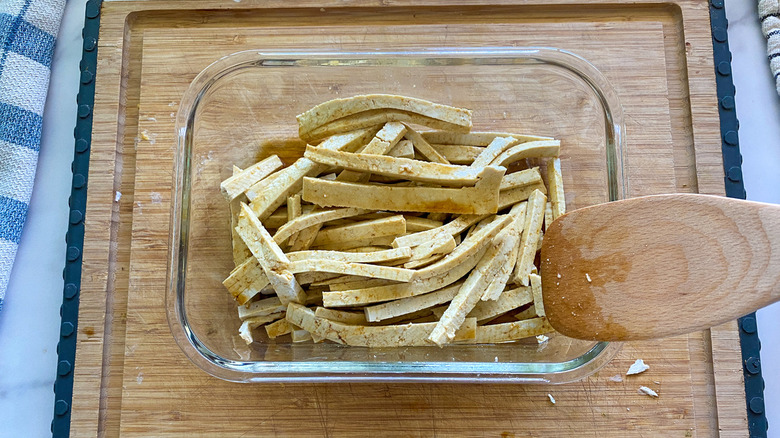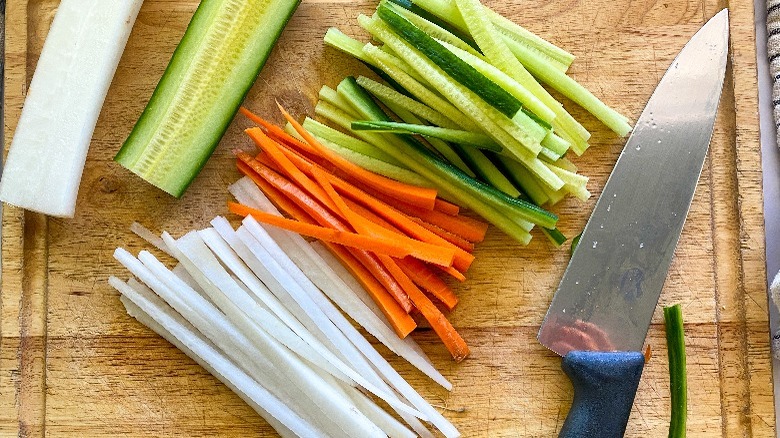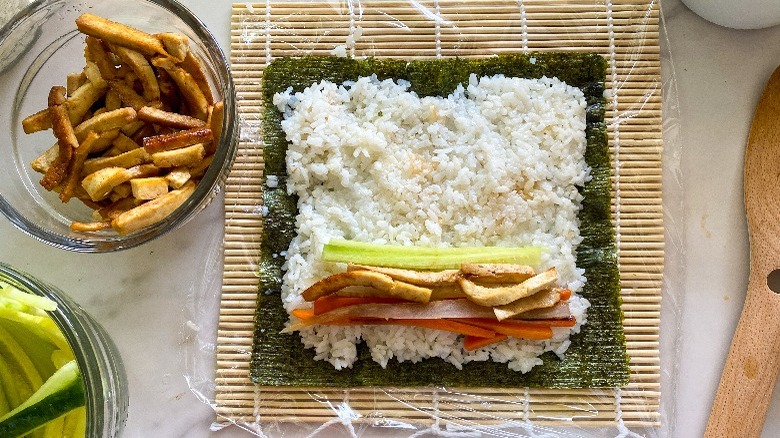Veggie Kimbap (Korean Seaweed Rice Rolls) Recipe
Korean cuisine offers a wide variety of delicious food and features fresh vegetables, rice, and flavorful sauces. Recipe developer and wellness coach Miriam Hahn brings us this Korean-inspired recipe for veggie kimbap and says, "This is one of my favorite Korean dishes to make. It's fresh and light, yet full of so much flavor."
Hahn also notes that "most people don't realize how healthy nori sheets are," so you can also count on a healthy dose of vitamins with each bite. So what's the difference between sushi and kimbap you ask? Although they do have similarities, the main difference is kimbap doesn't include raw fish and is seasoned with sesame oil instead of vinegar. However, both sushi and kimbap use nori sheets, vegetables and sticky rice to hold it all together. "Rolling the kimbap is actually easier than you think, as long as you have a bamboo rolling mat," Hahn remarks. Read on to learn how to enjoy this fabulous Korean meal.
Gather the ingredients for veggie kimbap
To make this recipe, you'll need some sushi rice, soy sauce, sesame oil, and nori sheets from the Asian department of the grocery store. "Sushi rice is very important here because it is much stickier than long grain rice and that is critical when rolling our kimbap," Hahn shares. You'll also need some maple syrup, avocado or olive oil, and salt. And then you'll want to swing by the produce department to grab some super firm tofu, carrots, an English cucumber, some spinach, and a daikon radish. Hahn tells us, "There are many types of tofu but if you can find the super firm variety it saves you the step of pressing the water out of the tofu and it holds up great in this kimbap."
Make the sushi rice and marinate the tofu
To get the rice cooking, you'll want to put the dry rice in a colander and rinse it under water for 2 minutes. This is helpful in removing the starch, so your rice doesn't get gummy. Once rinsed, put the rice in a bowl, cover with water, and soak for 30 minutes. Then drain and cook the rice either on the stove or with a rice cooker. Check the rice package for the specific cooking time if you're using your stove top. When the rice is done, transfer it to a bowl and mix it with the salt and 2 teaspoons of the sesame oil.
Remove the wrapper from the tofu and dry it off by wrapping it tightly in a paper towel or tea towel. Slice it into thin, ¼-inch julienne strips. Place the strips in a rectangle container. In a small bowl, combine the soy sauce, maple syrup, and 2 teaspoons of sesame oil. Pour this over the tofu and stir to coat all of the pieces. Let this marinate on the counter for 30 minutes.
Prepare the vegetables
In this step we're going to cut the carrots, cucumber, and daikon radish into thin julienne strips. To soften the carrots and daikon radish, add the oil to a frying pan and bring it to medium high heat. Cooking one vegetable at a time, add them to the pan and sauté for 2 minutes. Lastly, add the spinach to the pan and cook for 3 minutes or until wilted. Set these aside in separate bowls so they are ready to layer into the kimbap.
Roll the kimbap and serve
Pull out your bamboo mat and some plastic wrap. Wrap the bamboo mat completely in plastic wrap, going around a few times to make sure it is secure. (This keeps rice from getting stuck in between the bamboo sticks). Then lay down a nori sheet with the shiny side down. To add the rice layer, grab a scoop of rice (about ¾ cup) and press it down with your hands. Have a bowl of water nearby to dip your fingers in so the rice doesn't stick to them. Leave a ½-inch space at the top without rice, so you can seal the roll. Now go ahead and layer in the tofu, carrots, cucumber, radish, and spinach on the lower end of the mat towards you. Make sure not to overfill. Then bring up the bamboo mat, nori, and filling and make one full roll, pulling tightly as you go.
Once the first roll is complete, loosen the top edge of the mat so it is folding over in front of you. Repeat the rolling process until you have reached the top of the nori sheet. Remove the mat and seal the ends of the roll with a few dabs of water. Repeat the process with the remaining nori sheets. Using a sharp, serrated knife, slice the rolls into ½-inch slices and serve with soy sauce. Kimbap pairs well with a light soup or this pickled daikon roasted vegetable salad. This just might become your new favorite Korean dish!
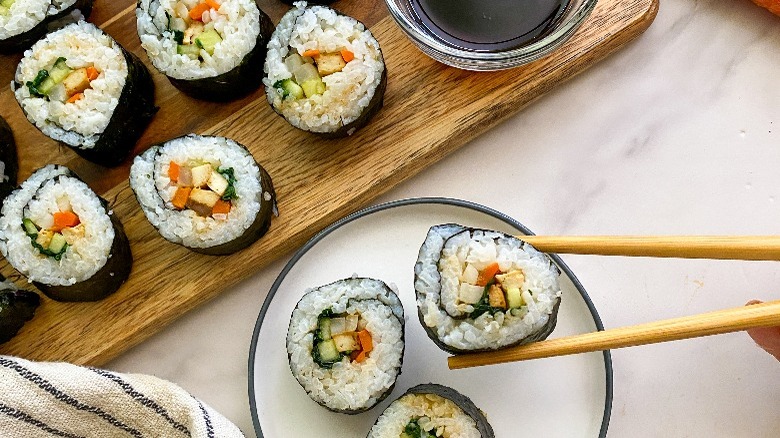
- 1 cup uncooked sushi rice
- ½ teaspoon salt
- 4 teaspoons sesame oil, divided
- ½ block (16-ounces) super firm tofu
- 2 tablespoons soy sauce
- 2 teaspoons maple syrup
- 1 tablespoon avocado or olive oil
- 2 small carrots, julienned
- ½ daikon radish, julienned
- 1 1/2 cups fresh spinach
- 3 nori sheets
- ½ English cucumber, julienned
- Rinse the rice in a colander for 2 minutes. Put in a bowl, cover with water, and soak for 30 minutes.
- Drain, then cook the rice per package instructions. When it is done, mix with the salt and 2 teaspoons of sesame oil and keep warm.
- Dry the tofu with paper towels. Slice into thin julienne strips and place in a rectangular container.
- Mix the soy sauce, maple syrup, and 2 teaspoons of the sesame oil in a small bowl. Pour the sauce over the tofu and let marinate for 30 minutes.
- Add the avocado or olive oil to a frying pan and heat to medium-high heat. Drop in the carrots and sauté for 2 minutes.
- Repeat the process for the daikon radish and spinach, working separately.
- Wrap a sushi mat completely with plastic wrap and seal on the bottom. Lay down a nori sheet, shiny side down. Spread about ¾ cup of the sticky rice onto the sushi roll, leaving about a ½-inch border so you can seal the sushi roll.
- Layer in the tofu, carrot, cucumber, radish, and spinach on the lower end of the mat towards you. Then, using the mat, roll the nori, rice, and fillings in a complete turn, pressing in tight with your fingers. Loosen the mat and repeat rolling.
- At the end, remove the mat and seal the ends together with water by wetting your fingers and rubbing them on the open edge. Repeat the process with 2 more nori sheets.
- When the nori roll is sealed, slice into ½-inch pieces and serve.
| Calories per Serving | 599 |
| Total Fat | 24.4 g |
| Saturated Fat | 3.5 g |
| Trans Fat | 0.0 g |
| Cholesterol | 0.0 mg |
| Total Carbohydrates | 69.5 g |
| Dietary Fiber | 6.0 g |
| Total Sugars | 6.6 g |
| Sodium | 928.3 mg |
| Protein | 30.6 g |
